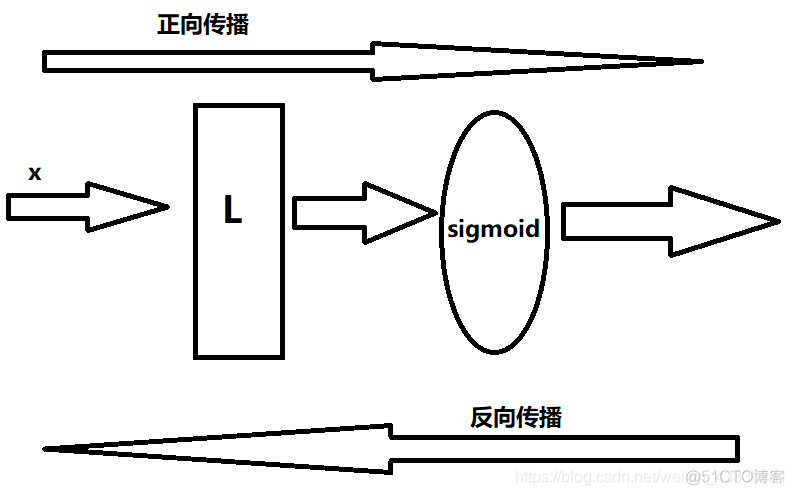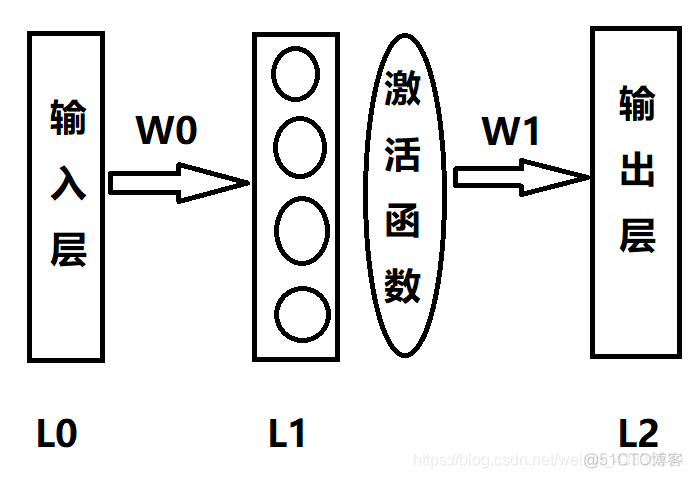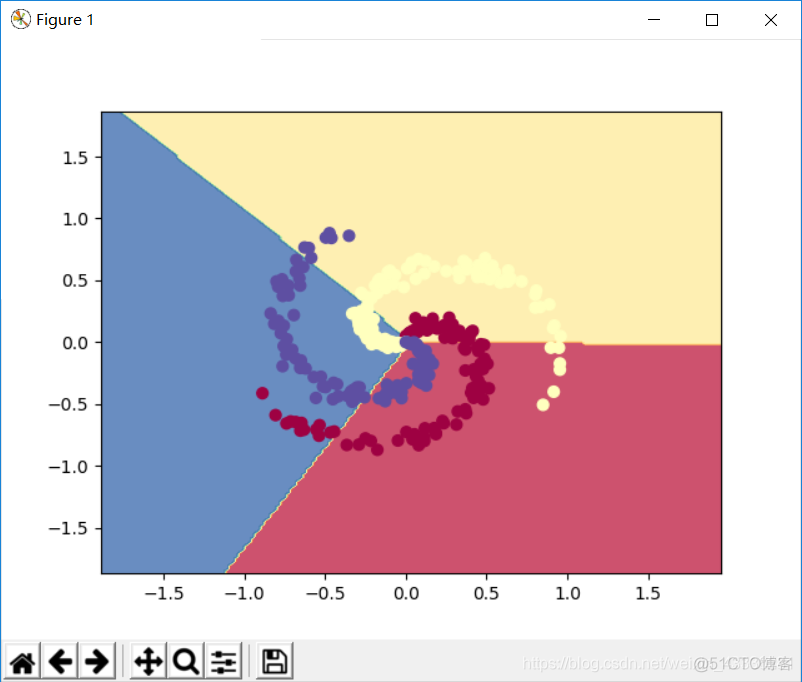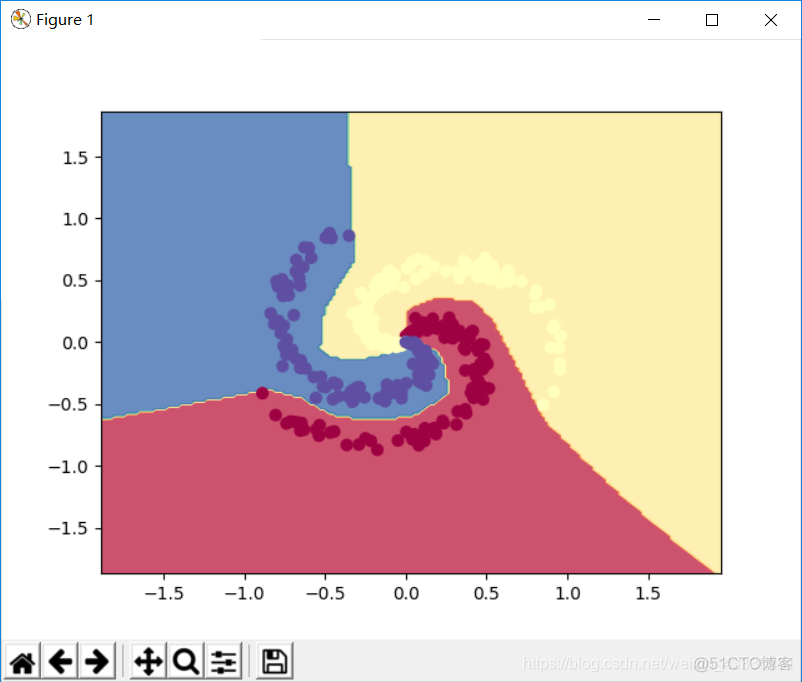15Python环境搭建(推荐Anaconda方法) 软件万能安装起点 python官网 Anaconda官网 16Eclipse搭建python环境 软件万能安装起点 python官网 Eclipse官
15Python环境搭建(推荐Anaconda方法)
软件万能安装起点
python官网
Anaconda官网
16Eclipse搭建python环境
软件万能安装起点
python官网
Eclipse官网
17动手完成简单神经网络
import numpy as npdef sigmoid (x,deriv=False):
if(deriv==True):
return x*(1-x)
return 1/(1+np.exp(-x))
x=np.array([
[0,0,1],
[0,1,1],
[1,0,1],
[1,1,1],
[0,0,1]
])
print(x.shape)
y=np.array([
[0],
[1],
[1],
[0],
[0]
])
print(y.shape)
np.random.seed(1)
w0=2*np.random.random((3,4))-1
w1=2*np.random.random((4,1))-1
for j in range(100000):
l0=x
l1=sigmoid(np.dot(l0,w0))
l2=sigmoid(np.dot(l1,w1))
l2_error=y-l2
if(j%10000)==0:
print('Error'+str(np.mean(np.abs(l2_error))))
l2_delta=l2_error*sigmoid(l2,deriv=True)
l1_error=l2_delta.dot(w1.T)
l1_delta=l1_error*sigmoid(l1,deriv=True)
w1 += l1.T.dot(l2_delta)
w0 += l0.T.dot(l1_delta)
代码分析
激活函数

'''
激活函数
:param x:
:param deriv:标志位,当derive为假时,不计算导数,反之计算,控制传播方向。
:return:
'''
if(deriv==True):
# 求导
return x*(1-x)
return 1/(1+np.exp(-x))
激活函数参见:机器学习——01、机器学习的数学基础1 - 数学分析——Sigmoid/Logistic函数的引入
定义input和lable值
x=np.array([[0,0,1],
[0,1,1],
[1,0,1],
[1,1,1],
[0,0,1]
])
y=np.array([
[0],
[1],
[1],
[0],
[0]
])
可以看一下x和y的维度:
print(x.shape)print(y.shape)

指定随机种子
np.random.seed(1)保证数据一致,方便对比结果。
初始化权重值
#定义w0和w1在-1到1之间w0=2*np.random.random((3,4))-1
#三行对应x的三个特征,四列对应L1层的四个神经元
w1=2*np.random.random((4,1))-1
#四行对应L1的四个神经元,一列对应输出0或1
定义三层神经网络
l0=x#L0层为输入层
#进行梯度传播操作:
l1=sigmoid(np.dot(l0,w0))
#L0与W0进行矩阵运算得到L1
l2=sigmoid(np.dot(l1,w1))
#L1与W1进行矩阵运算得到L2

根据误差更新权重
l2_error=y-l2#预测值与真实值之间的差异
if(j%10000)==0:
print('Error'+str(np.mean(np.abs(l2_error))))
#打印误差值
l2_delta=l2_error*sigmoid(l2,deriv=True)
#反向传播求导,差异值越大,需要更新的越大
l1_error=l2_delta.dot(w1.T)
#w1进行转置之后与l2_delta进行矩阵运算
l1_delta=l1_error*sigmoid(l1,deriv=True)
#更新w1和w2
w1 += l1.T.dot(l2_delta)
w0 += l0.T.dot(l1_delta)
18感受神经网络的强大
假设有如下数据要将其分类

代码
import numpy as npimport matplotlib.pyplot as plt
#ubuntu 16.04 sudo pip instal matplotlib
plt.rcParams['figure.figsize'] = (10.0, 8.0) # set default size of plots
plt.rcParams['image.interpolation'] = 'nearest'
plt.rcParams['image.cmap'] = 'gray'
np.random.seed(0)
N = 100 # number of points per class
D = 2 # dimensionality
K = 3 # number of classes
X = np.zeros((N*K,D))
y = np.zeros(N*K, dtype='uint8')
for j in range(K):
ix = range(N*j,N*(j+1))
r = np.linspace(0.0,1,N) # radius
t = np.linspace(j*4,(j+1)*4,N) + np.random.randn(N)*0.2 # theta
X[ix] = np.c_[r*np.sin(t), r*np.cos(t)]
y[ix] = j
fig = plt.figure()
plt.scatter(X[:, 0], X[:, 1], c=y, s=40, cmap=plt.cm.Spectral)
plt.xlim([-1,1])
plt.ylim([-1,1])
plt.show()
传统AI算法
#Train a Linear Classifierimport numpy as np
import matplotlib.pyplot as plt
np.random.seed(0)
N = 100 # number of points per class
D = 2 # dimensionality
K = 3 # number of classes
X = np.zeros((N*K,D))
y = np.zeros(N*K, dtype='uint8')
for j in range(K):
ix = range(N*j,N*(j+1))
r = np.linspace(0.0,1,N) # radius
t = np.linspace(j*4,(j+1)*4,N) + np.random.randn(N)*0.2 # theta
X[ix] = np.c_[r*np.sin(t), r*np.cos(t)]
y[ix] = j
W = 0.01 * np.random.randn(D,K)
b = np.zeros((1,K))
# some hyperparameters
step_size = 1e-0
reg = 1e-3 # regularization strength
# gradient descent loop
num_examples = X.shape[0]
for i in range(1000):
#print X.shape
# evaluate class scores, [N x K]
scores = np.dot(X, W) + b #x:300*2 scores:300*3
#print scores.shape
# compute the class probabilities
exp_scores = np.exp(scores)
probs = exp_scores / np.sum(exp_scores, axis=1, keepdims=True) # [N x K] probs:300*3
print (probs.shape )
# compute the loss: average cross-entropy loss and regularization
corect_logprobs = -np.log(probs[range(num_examples),y]) #corect_logprobs:300*1
print (corect_logprobs.shape)
data_loss = np.sum(corect_logprobs)/num_examples
reg_loss = 0.5*reg*np.sum(W*W)
loss = data_loss + reg_loss
if i % 100 == 0:
print ("iteration %d: loss %f" % (i, loss))
# compute the gradient on scores
dscores = probs
dscores[range(num_examples),y] -= 1
dscores /= num_examples
# backpropate the gradient to the parameters (W,b)
dW = np.dot(X.T, dscores)
db = np.sum(dscores, axis=0, keepdims=True)
dW += reg*W # regularization gradient
# perform a parameter update
W += -step_size * dW
b += -step_size * db
scores = np.dot(X, W) + b
predicted_class = np.argmax(scores, axis=1)
print ('training accuracy: %.2f' % (np.mean(predicted_class == y)))
h = 0.02
x_min, x_max = X[:, 0].min() - 1, X[:, 0].max() + 1
y_min, y_max = X[:, 1].min() - 1, X[:, 1].max() + 1
xx, yy = np.meshgrid(np.arange(x_min, x_max, h),
np.arange(y_min, y_max, h))
Z = np.dot(np.c_[xx.ravel(), yy.ravel()], W) + b
Z = np.argmax(Z, axis=1)
Z = Z.reshape(xx.shape)
fig = plt.figure()
plt.contourf(xx, yy, Z, cmap=plt.cm.Spectral, alpha=0.8)
plt.scatter(X[:, 0], X[:, 1], c=y, s=40, cmap=plt.cm.Spectral)
plt.xlim(xx.min(), xx.max())
plt.ylim(yy.min(), yy.max())
plt.show()

神经网络算法
import numpy as npimport matplotlib.pyplot as plt
np.random.seed(0)
N = 100 # number of points per class
D = 2 # dimensionality
K = 3 # number of classes
X = np.zeros((N*K,D))
y = np.zeros(N*K, dtype='uint8')
for j in range(K):
ix = range(N*j,N*(j+1))
r = np.linspace(0.0,1,N) # radius
t = np.linspace(j*4,(j+1)*4,N) + np.random.randn(N)*0.2 # theta
X[ix] = np.c_[r*np.sin(t), r*np.cos(t)]
y[ix] = j
h = 100 # size of hidden layer
W = 0.01 * np.random.randn(D,h)# x:300*2 2*100
b = np.zeros((1,h))
W2 = 0.01 * np.random.randn(h,K)
b2 = np.zeros((1,K))
# some hyperparameters
step_size = 1e-0
reg = 1e-3 # regularization strength
# gradient descent loop
num_examples = X.shape[0]
for i in range(2000):
# evaluate class scores, [N x K]
hidden_layer = np.maximum(0, np.dot(X, W) + b) # note, ReLU activation hidden_layer:300*100
#print hidden_layer.shape
scores = np.dot(hidden_layer, W2) + b2 #scores:300*3
#print scores.shape
# compute the class probabilities
exp_scores = np.exp(scores)
probs = exp_scores / np.sum(exp_scores, axis=1, keepdims=True) # [N x K]
#print probs.shape
# compute the loss: average cross-entropy loss and regularization
corect_logprobs = -np.log(probs[range(num_examples),y])
data_loss = np.sum(corect_logprobs)/num_examples
reg_loss = 0.5*reg*np.sum(W*W) + 0.5*reg*np.sum(W2*W2)
loss = data_loss + reg_loss
if i % 100 == 0:
print ("iteration %d: loss %f" % (i, loss))
# compute the gradient on scores
dscores = probs
dscores[range(num_examples),y] -= 1
dscores /= num_examples
# backpropate the gradient to the parameters
# first backprop into parameters W2 and b2
dW2 = np.dot(hidden_layer.T, dscores)
db2 = np.sum(dscores, axis=0, keepdims=True)
# next backprop into hidden layer
dhidden = np.dot(dscores, W2.T)
# backprop the ReLU non-linearity
dhidden[hidden_layer <= 0] = 0
# finally into W,b
dW = np.dot(X.T, dhidden)
db = np.sum(dhidden, axis=0, keepdims=True)
# add regularization gradient contribution
dW2 += reg * W2
dW += reg * W
# perform a parameter update
W += -step_size * dW
b += -step_size * db
W2 += -step_size * dW2
b2 += -step_size * db2
hidden_layer = np.maximum(0, np.dot(X, W) + b)
scores = np.dot(hidden_layer, W2) + b2
predicted_class = np.argmax(scores, axis=1)
print ('training accuracy: %.2f' % (np.mean(predicted_class == y)))
h = 0.02
x_min, x_max = X[:, 0].min() - 1, X[:, 0].max() + 1
y_min, y_max = X[:, 1].min() - 1, X[:, 1].max() + 1
xx, yy = np.meshgrid(np.arange(x_min, x_max, h),
np.arange(y_min, y_max, h))
Z = np.dot(np.maximum(0, np.dot(np.c_[xx.ravel(), yy.ravel()], W) + b), W2) + b2
Z = np.argmax(Z, axis=1)
Z = Z.reshape(xx.shape)
fig = plt.figure()
plt.contourf(xx, yy, Z, cmap=plt.cm.Spectral, alpha=0.8)
plt.scatter(X[:, 0], X[:, 1], c=y, s=40, cmap=plt.cm.Spectral)
plt.xlim(xx.min(), xx.max())
plt.ylim(yy.min(), yy.max())
plt.show()

